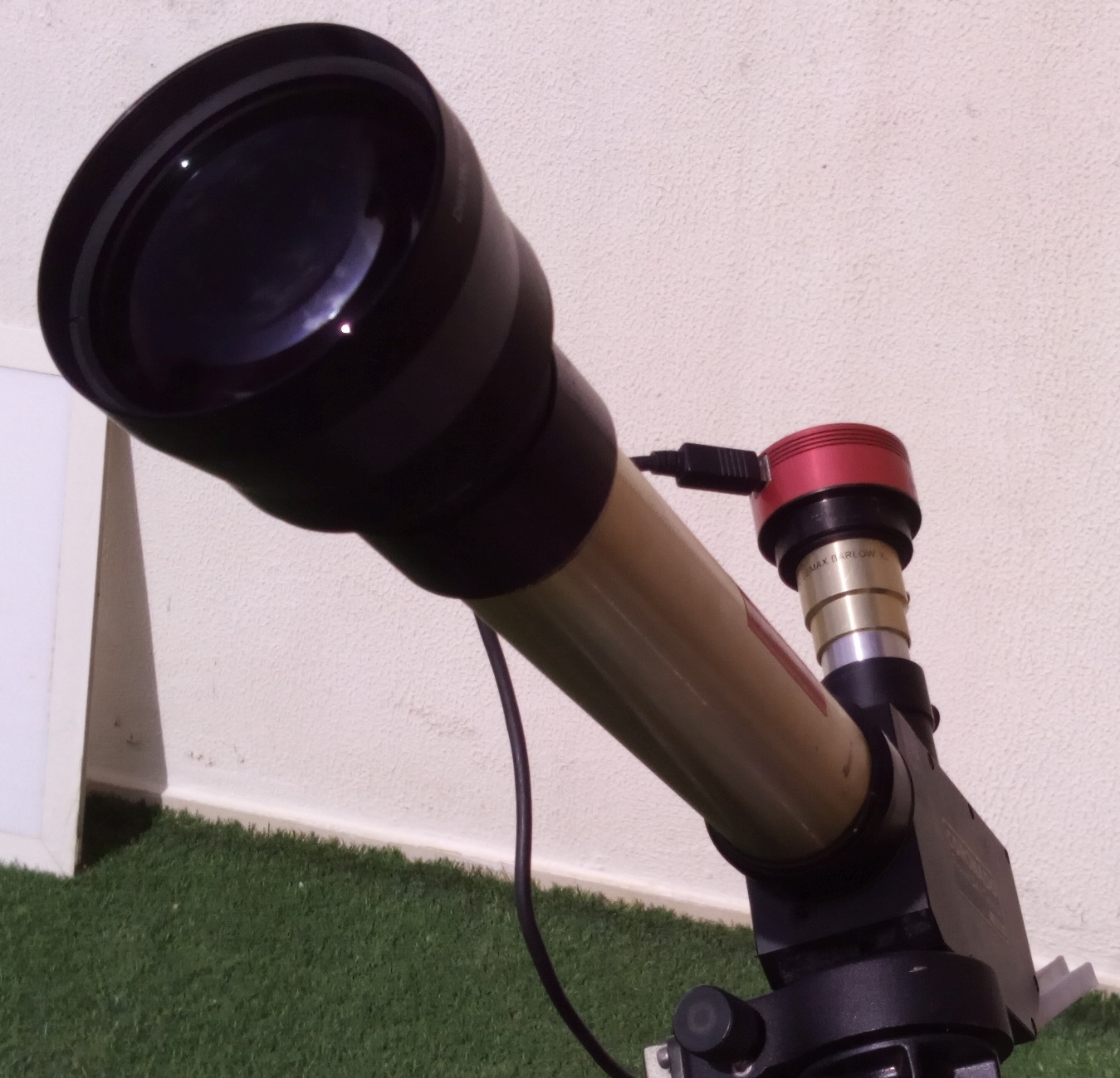
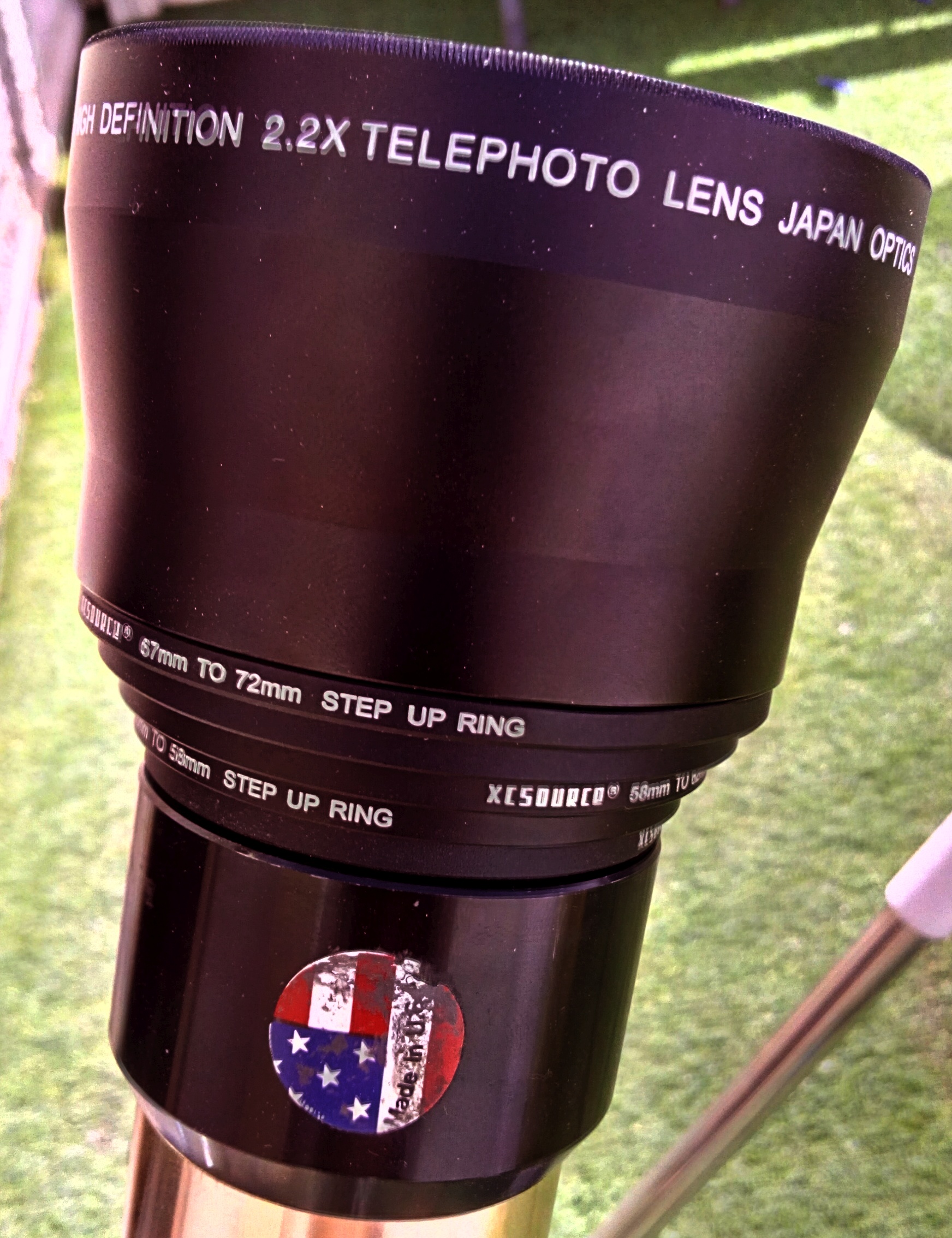
Coronado PersonalSolarTelescope
(click on most images for larger size)
A revolution for the
Coronado
PST !
Episode II !
20190408
I bought last year on Ebay a rather cheap
(item ID 192634366900, ~40$) 2.2X telephoto lens for my Nikon Coolpix
P1000 ... It was terrible with an incredible amount of chromatism
... Finaly I never used it after initial testing with the P1000.
Today I had the idea that it could be better for monochromatic light as Halpha
... Success !!
When I added it just with a few rings to my PST, it was instantly tranformed
into an incredibly nice 80 mm aperture, ~
800 mm focal length Halpha refractor !!


I used an ASI 174 MM camera to make 1 min SER videos. Processing AS!3, RegiStax6 a StarMax Square
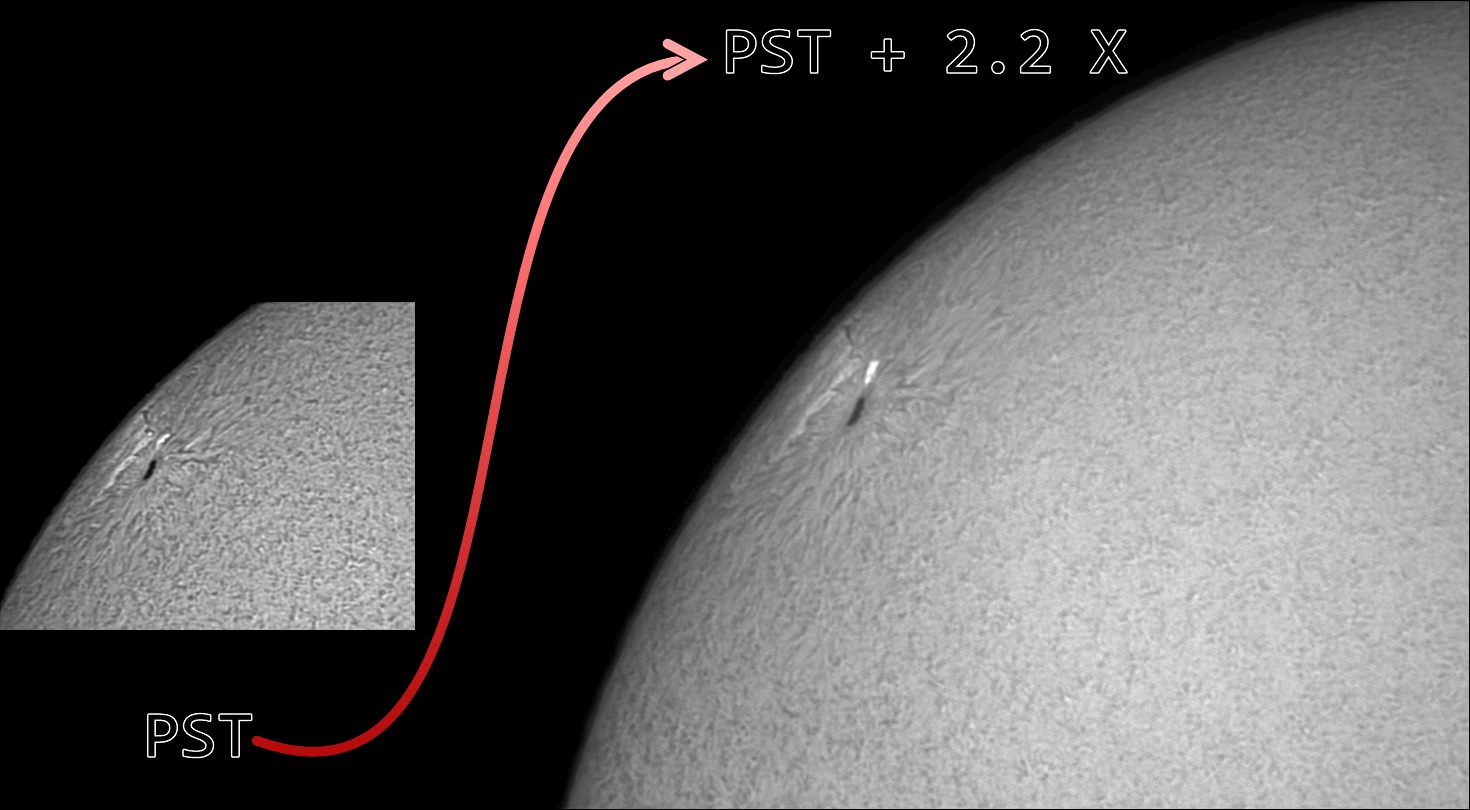
20190412 17:32 LT (Israel)
Translation (motor stopped) and SER processing with
RegiStax5 / extended mode.
... and seems to break down (here double stack) !
20190510 (AR2740)
The sunspot is quiet ... but monitored with FlareCapture !
PST with 2.2x extender (see http://sweiller.free.fr/).
1 min capture with ASI174MM in USB2 more stable on my PC, 7 FPS) using FireCapture
(2.5.10 X64, Gain 123, exp 3500 ms, gamma 30).
Registration AS!3(conv 45,
50% best), Wv Processing Registax6 (WSL1_0G_WVb250g100v784__LMIX_R917G691B1)
including colorization.
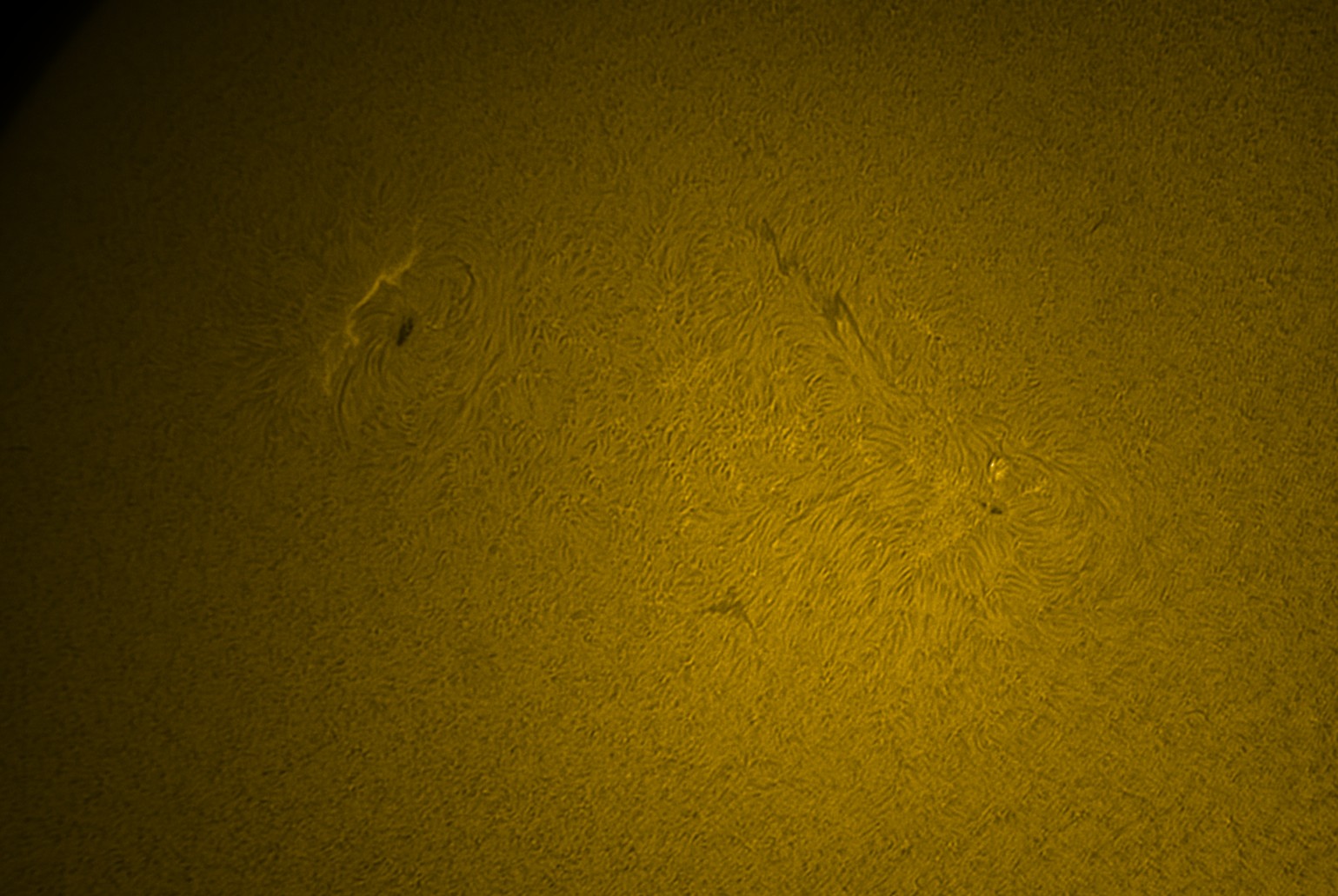
Episode
I !
20180930
_101722_lapl4_ap2660_convLRD033I17-Spot-R60200100220Gam100.png)
_102353_lapl4_ap816_convLRD033I17R6WVG0250100521Gam11.png)
Both images Coronado PST double stack (400
mm FL), ASI 174 MM global shutter camera,
Firecapture .SER file, 60 sec,
Left PST
(aperture 40 mm, with CEMAX 2x barlow -> 800 mm FL, camera :
8 ms,gain 230, gamma 50),
Right added the 1.5x CAMERA extender
in front (aperture of 50 mm, with CEMAX 2x barlow -> 1200
mm FL, camera :
10 ms, gain 289, gamma 1),
Processing : AS!3 + convolution 50, Astro Image LRD .33 I 17, RegiStax6 WVG0250100521Gam11
(L)
WVG0200100220Gam100 (R)
SETUP :
20180920

Both sides, same Firecapture of 30s, both within a couple
of
minutes ...
The 1.5x CAMERA extender having
an aperture of 50 mm and driving the
PST
(40 mm) at
now 600 mm FL instead of 400 mm,
it not astonishing as I suspected,
that
resolution
of the prominences would
greatly improve !
I am sure it will
be
very interesting
to experiment with
a
high definition 2x
or 2.2x extender (one is ordered)
!
A ring 58 to 42 mm does the link.
Visually it is nice too !
Details on the camera extender (click for larger pictures) to be simply screwed on the front end of the PST !
20140319
Just before sunset ... for the fun, pass of birds of prey (commun Hawks) !
Note that the Watec 902-H2 Ultimate reaches focus on the standard PST with a short nozzle and no barlow !
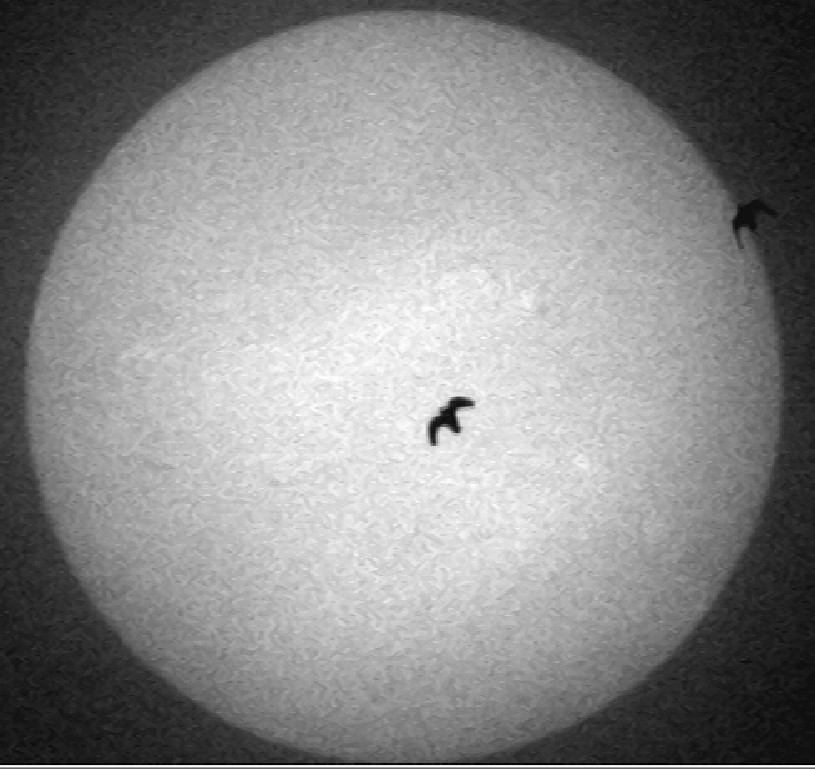
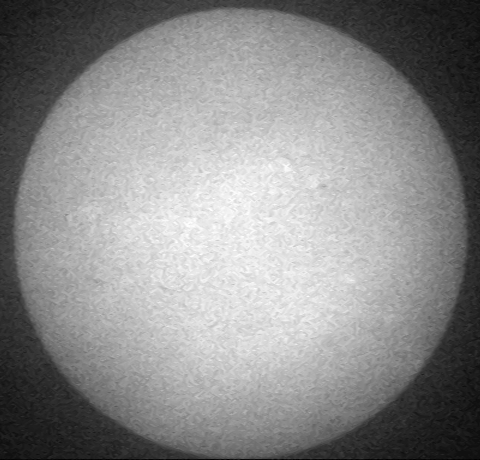
Eyepiece projection (MARK III Hyperion Zoom 8-24 mm + M42 adaptation and PL1-M camera) for PST ...

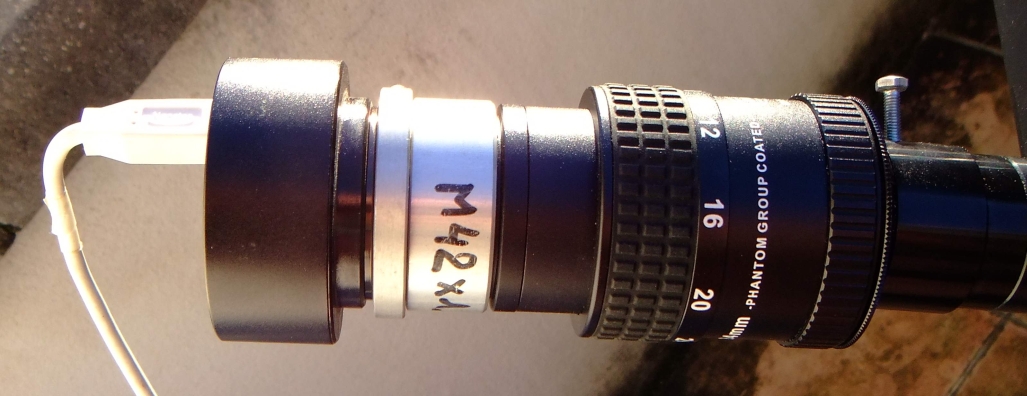
For information
processing with Lusol then StarMax ... 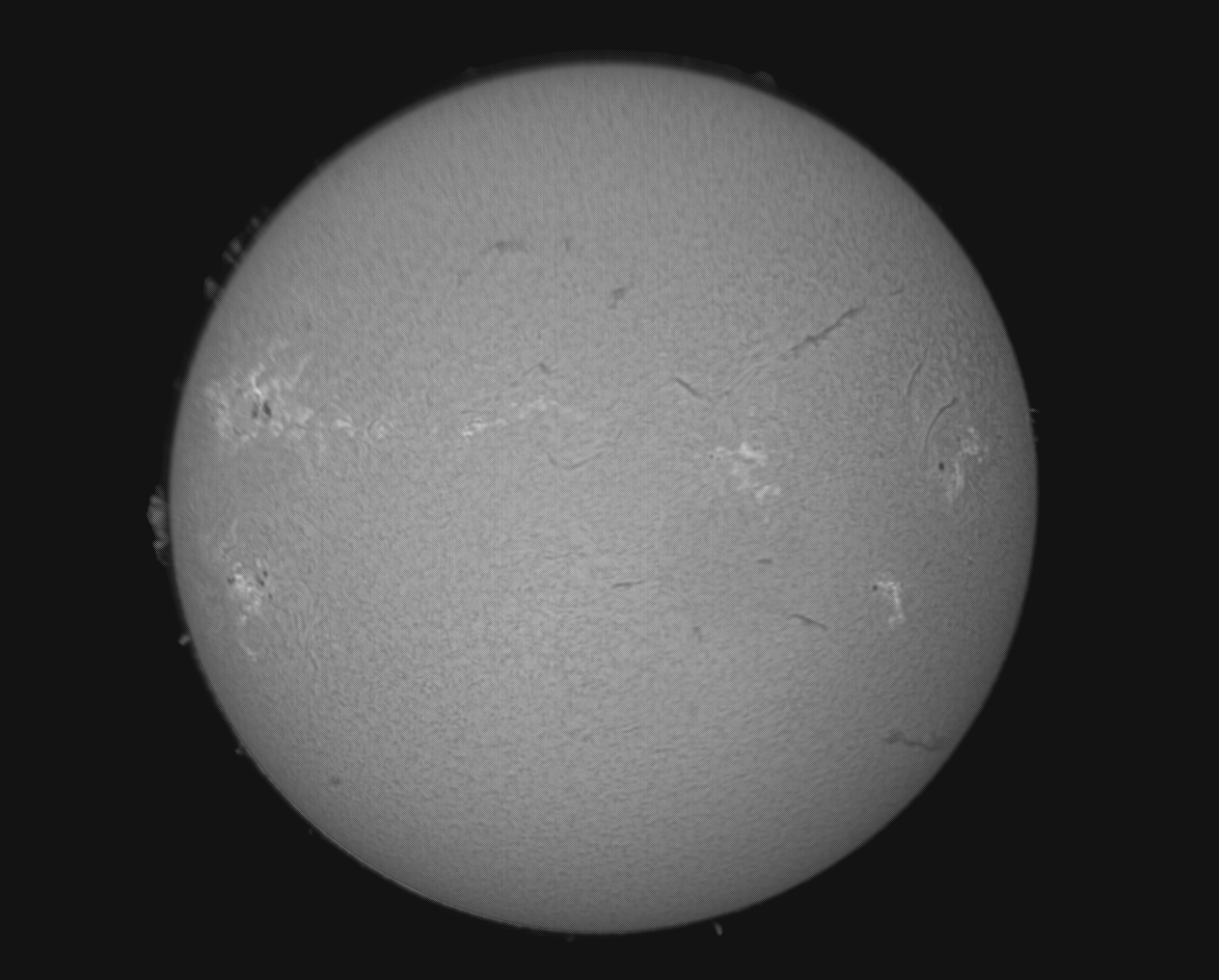
Note : fast done in between passing clouds !!
My best eyepiece for PST ...
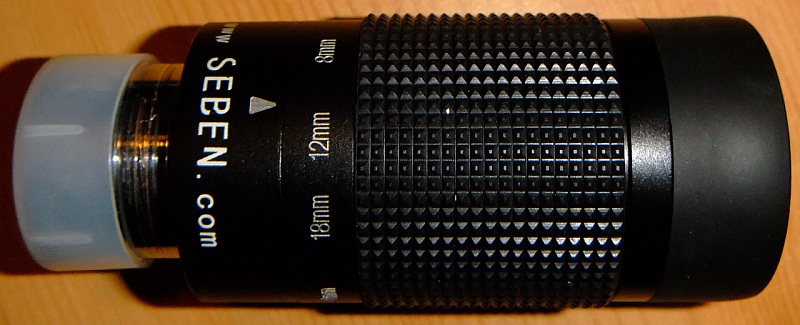
20130425
click on image for full size
Very nice weather today to catch our flamboyant star in H-alpha
!
While following AR1726 in high resolution with another instrument for a chance
of big flare I took this image of the whole Sun with my PST-DS and a Coolpix
8400
(15 mm eyepiece projection). Processing of TIFF pictures with AS!2 and
RegiStax6 using special gamma curves. Solar oriented image.
20130402 (13:12...13:16 UT):
PST-DS* + 1.6 MagniMax barlow without tube +
DMK31 ...
* Double-stacked with SM40 II +TMax (click here for detailed 3D SM40 II pictures !)
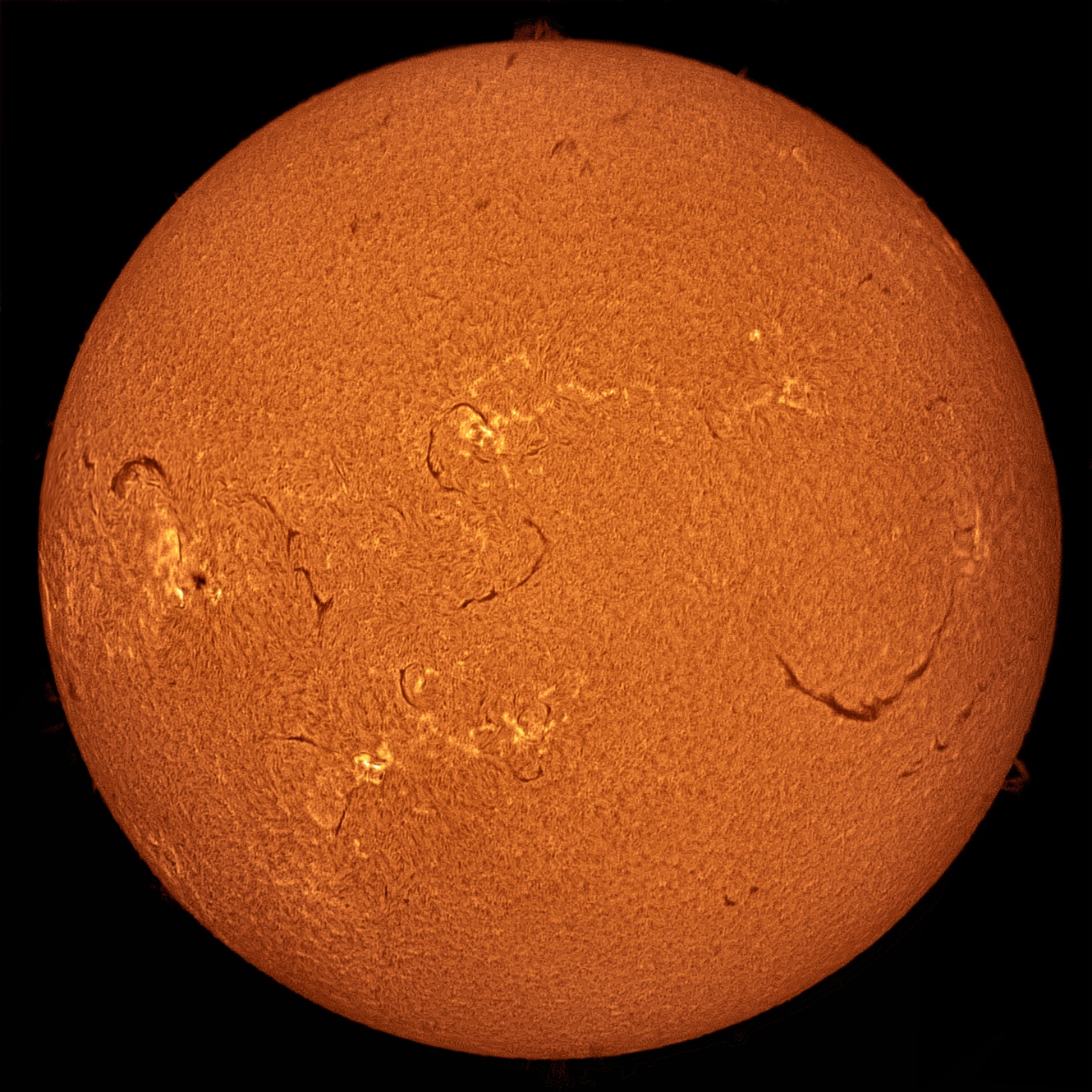
Conditions :
Videos Sky (E. Rietsch) for capturing 7 fields of 500 unsaturated frames SER
files @ 30 fps set but 10 fps real !
Registration with Autostakkert2, 425 best frames stacked
into PNG
Sharpening in Registax 6 with WV 17-160-79
Mosaic with Microsoft ICE freeware
Colorization with GIMP2, Finalisation PSP
20130314 : Standard original
PST + 1.6 MagniMax barlow without tube + DMK31 ...
Half Sun ... then full SUN !

Due to clouds I was not able to make a full Sun image with this same quality ... here mosaic of 2 images with microsoft ICE.
I was motivated to do a lot of
tests and comparisons after an helpful discussion in the Coronado-PST Yahoo
group following
the post of an amazing mosaic of one of the members using a double-stack
PST, a CEMAX barlow and a DMK31 (+ flat frames) :
http://www.astrobin.com/uploads/d87889f3-7024-4801-a1b9-a2b60a0a5376.png
I was avid to see what kind of resolution I could get with the standard
PST using the same camera I had just from a few days and about the same barlow.
I had not the opportunity to make flats.
Conditions :
Videos Sky (E. Rietsch) for capturing 200 unsaturated and even a bit dark frames
@ 30 fps set but 7.5 fps real
Registration with Autostakkert2 (I used also tested Registax 5 and Registax
6 on those movies but results were a very little bit below), 49 best
frames stacked into
PNG
Sharpening in Registax 6 with WV values of 100 / 80.4
Mosaic with Microsoft ICE freeware
Square of picture (multiplied by itself, Div factor 100) to enhance constrast
like what was done with slides
Colorization with GIMP2
0.5 Gaussian in GIMP2
Well, my best standard PST result
to this day ! Hopefully, I should upgrade to double stack soon ...
The next day I was able to find a 3/4 complete
sequence
with no clouds done
at the center
of the Sun ...
This enabled me to use again ICE to fulfill the complete mosaic !
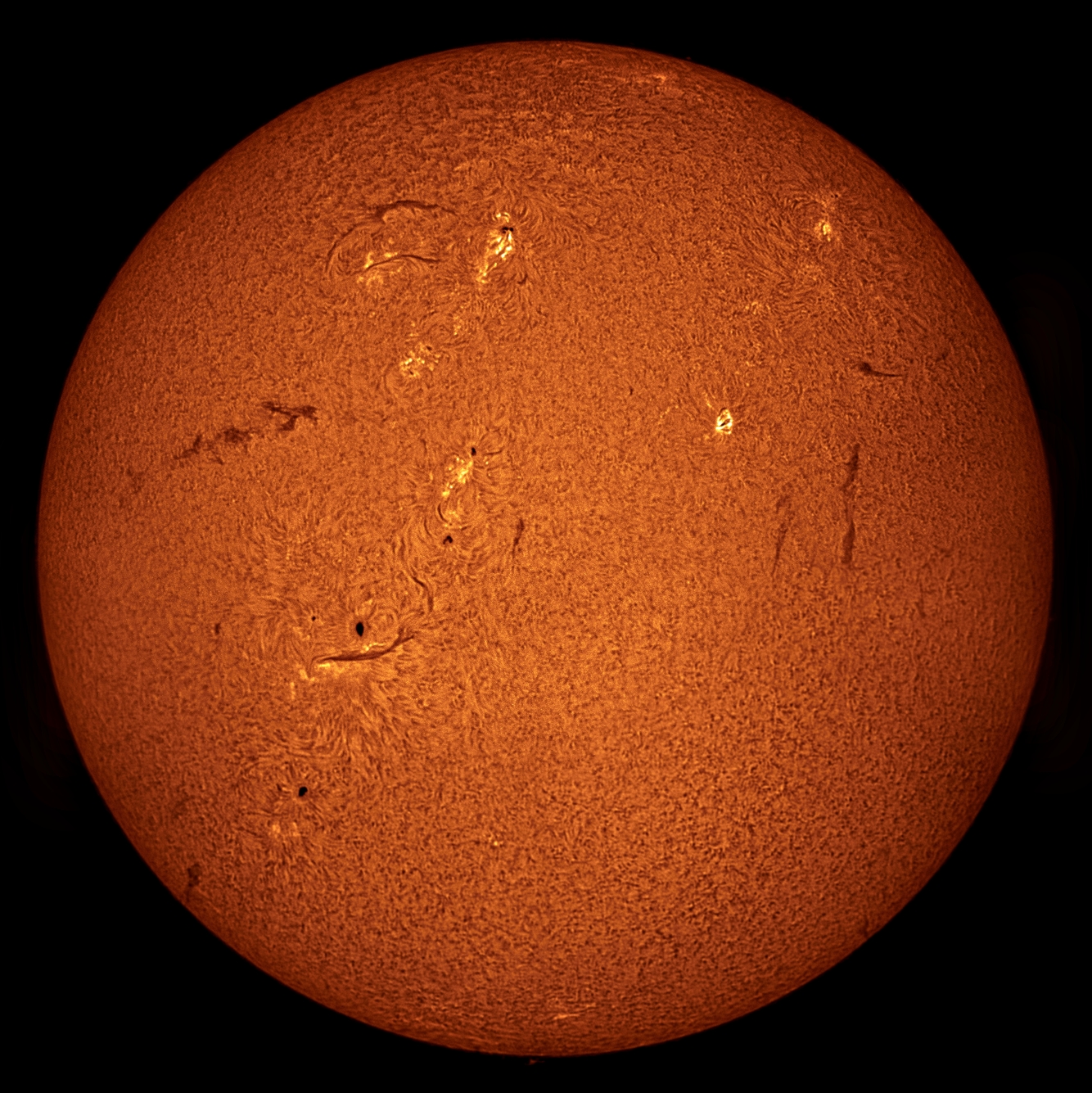
I tried to improve the result
who showed dark zones and some visible joins by doing the following :
1. I glued the center image from the center sequence over the mosaic using
PSP and
-- aligning with Layers / Differences
-- gluing in Lighten mode
-- I applied the mathematical Square to the image
-- selecting zones with the lasso using a very large feathering and applying
as much as needed more luminosity
(to better see the effect, the viewing and luminosity applying was done under
a 30% zoom)
After colorization in GIMP, I increased visibility of structures using a
size of 30 and a factor of 0.5 (filaments are nicer) then I applied a
final .5 gaussian.
Started 20130409 : Adaptation of a Coolpix 8400 on a standard PST for one shot full Sun HAlpha pictures
UR-E15 adaptor (For adding a
3x ED zoom) at left and 15mm Plössl eyepiece (hot) glued
after alignement and in two steps to 28 -37 mm step-up ring at right
NOTE : Other trials ... The
Coolpix 8400 is
very insensitive to the violet CaK light !
When zooming at the level for the Sun to
fill the LCD screen, this one is completely black. No focusing can be done
whatsoever.
About 8 sec needed for exposures (max ISO used, 400) but result completely
blurred :(
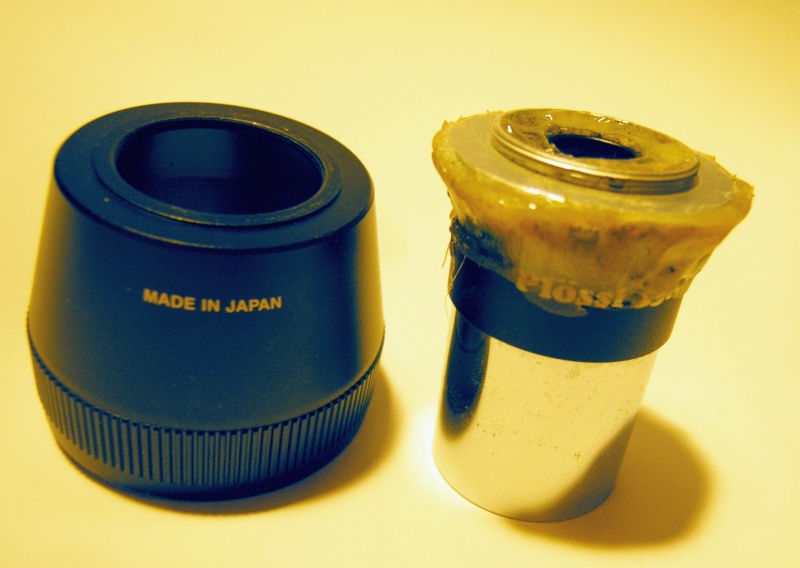
Final setup on camera
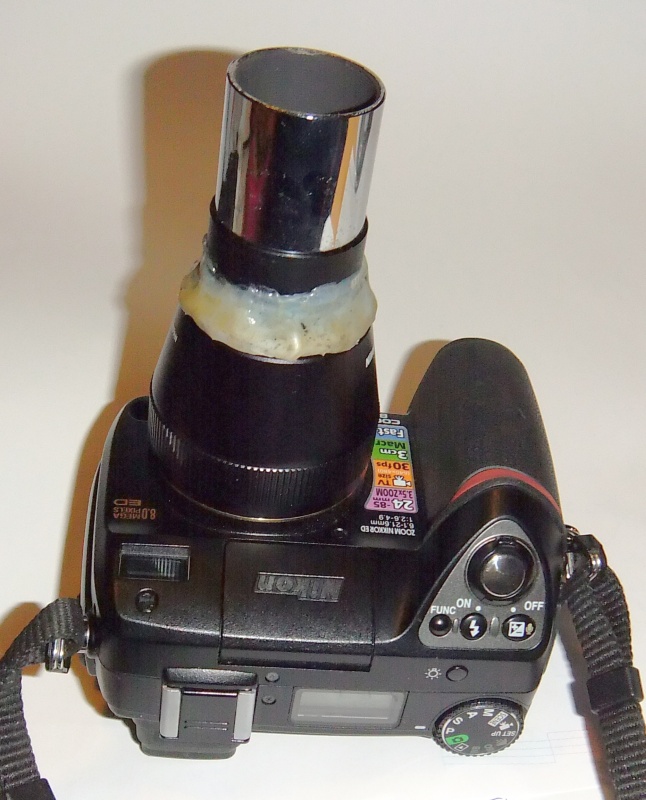

Result obtained dispite of haze
from 60s, 640x480 .MOV converted to AVI.
Power 4 of image !
RegiStax6 wavelets (WSL1_0G_WVb0g80v767)
PST-DS + 20 mm eyepiece and the Collpix 8400 (CCD sensor, 2/3" !)
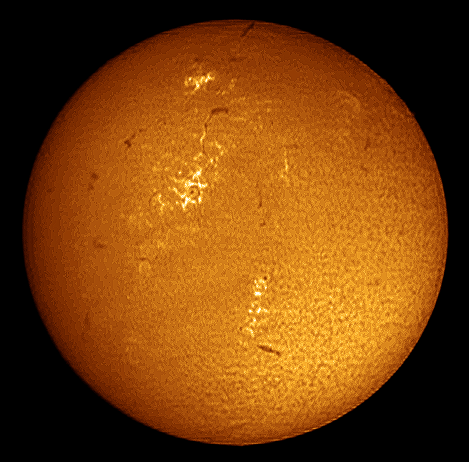
With the 15mm Plössl eyepiece the Sun is just framed at full zoom (3.5x) when taking videos (Capability 60s, 640x480, color only)
Now below processing of a single image
(the one in grey) with still hazy skies
(20130412-1400UT) TIff manual mode in B&W, Focus infinite, high contrast,
1/8s, Max zoom, F 4.9, ISO
100, 3s timer
.jpg)
.jpg)
Registax6 wavelets, Power 4 (squared twice) and colorization with Gimp2
Older TRIALS ....
Note : first trial during
a brake in the clouds for faisability (below)
was done with the standard PST-DS + 20 mm eyepiece and the C8400 (CCD sensor,
2/3"
!)
hold
by
hand
on it (Max zoom = 3.5), 1/2s exposure, F/4.9, 200ISO, F(equ 35mm : 85)
PST on
tripod)
...
No time to focus.Gamma has been increased for
you to see the whole field (otherwise black), size reduced 5x here the
original diameter of the Sun being 1250 pixels.
With the 15mm Plössl eyepiece
I expect the Sun to be 25% larger. I may try later with a <=10 mm eyepiece to
fill as much space as possible ...
(Note that exposure was much too long as red layer is saturated on the disk
... correct exposure would have been < 1/20s)
With the 15mm Plössl eyepiece the
Sun to be much larger. This shot is without DS and about 2 hours after M6
eruption (20130411) in haze seeing.
I seems to be a good compromise between field ans size on a tripod.
I may
try later with
a <=10
mm eyepiece to fill as much space as possible on an equatorial mount ...
(Note the exposure is still to long at least with no DS as I get much of the
signal in the green layer : 1/125s, F 7.7, ISO 200 ... Prominences are visible
yet)
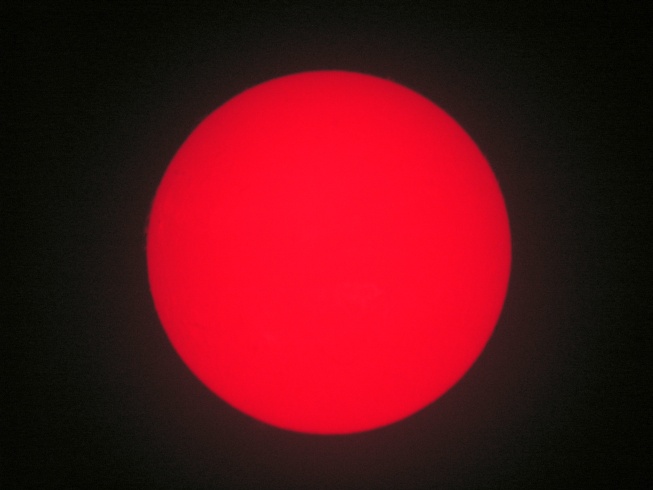
20130221 : A modified PST for easy use (and focusing) of a webcam or astronomical Camera (3D pictures)
20130220 / Second trial with standard PST, Powermate 5x and Canon 500D in full HD movie mode (underexposed -2 EV)
Autostakkert PNG (more
details visible) 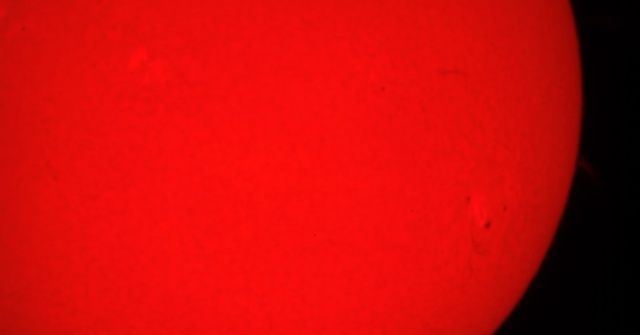 Best
RegiStax6 disk result
Best
RegiStax6 disk result 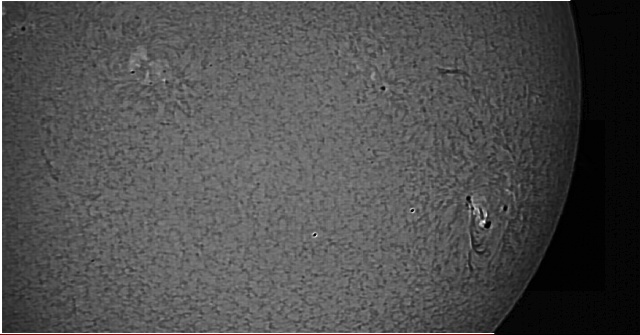
Best RegiStax6 gamma curves compromise 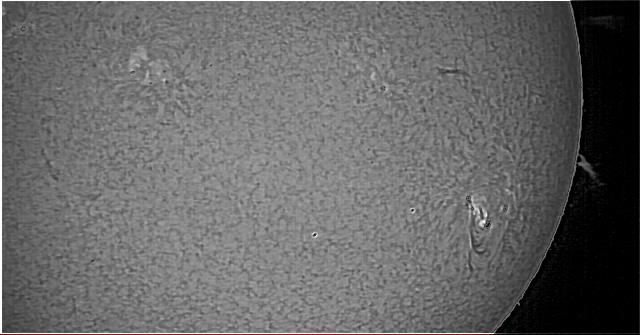 Mix
trial with lasso in PSP
Mix
trial with lasso in PSP 
20130219 / First trial with standard
PST, Powermate 5x and Canon 500D in full HD movie mode after C1 flare
Full image obtained with Autostakkert2 and RegiStax6
RegiStax6 screen : As I use mainly the green layer, I should use shorter exposures !
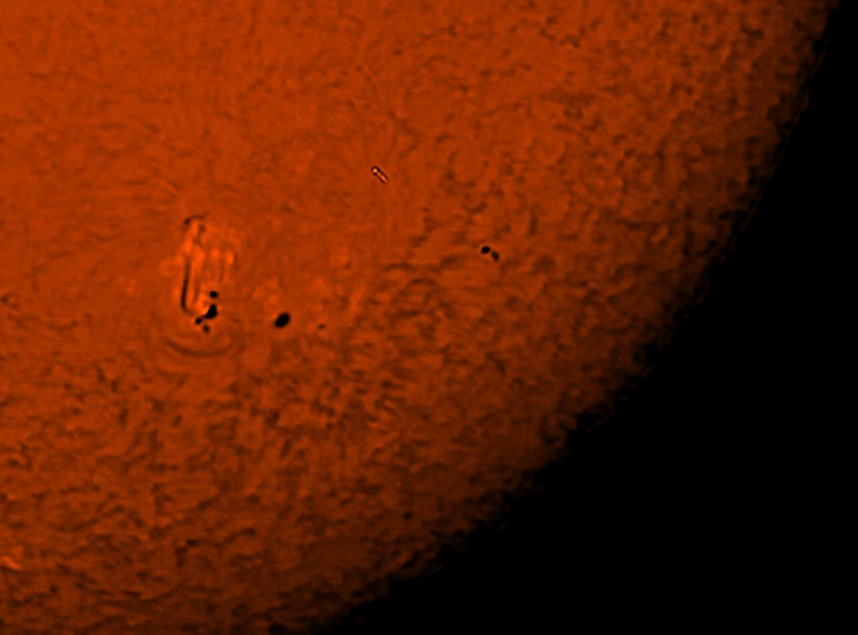
20120127- PST and Canon 40D
-RegiStax5&6-WSL1_0G_WVb500g120v558_CB100_0_GA186_HIRGB_9_255_G186-Irfanview40%25Sharpen.jpg)
The Sun, not far from what is
seen directly in the linearized JMI focused PST. Equatorial mount not motorized.
Single image (due to large clouds !) with the Canon 40D in monochrome mode which
allows a better liveview vision than all red .
1/20s, ISO 200, 2X barlow (see here).
CR2 picture transformed in PNG inside RegiStax5.
PNG processed in RegiStax6 (histogram + gamma curves)
See
here for original picture
Below processing of 20 similar pictures
(letting the Sun move in beetwen shots (10s) to make an artificial flat)
Note : to see the screen copy full size, copy it then paste in a paint program
(Irfanview...)
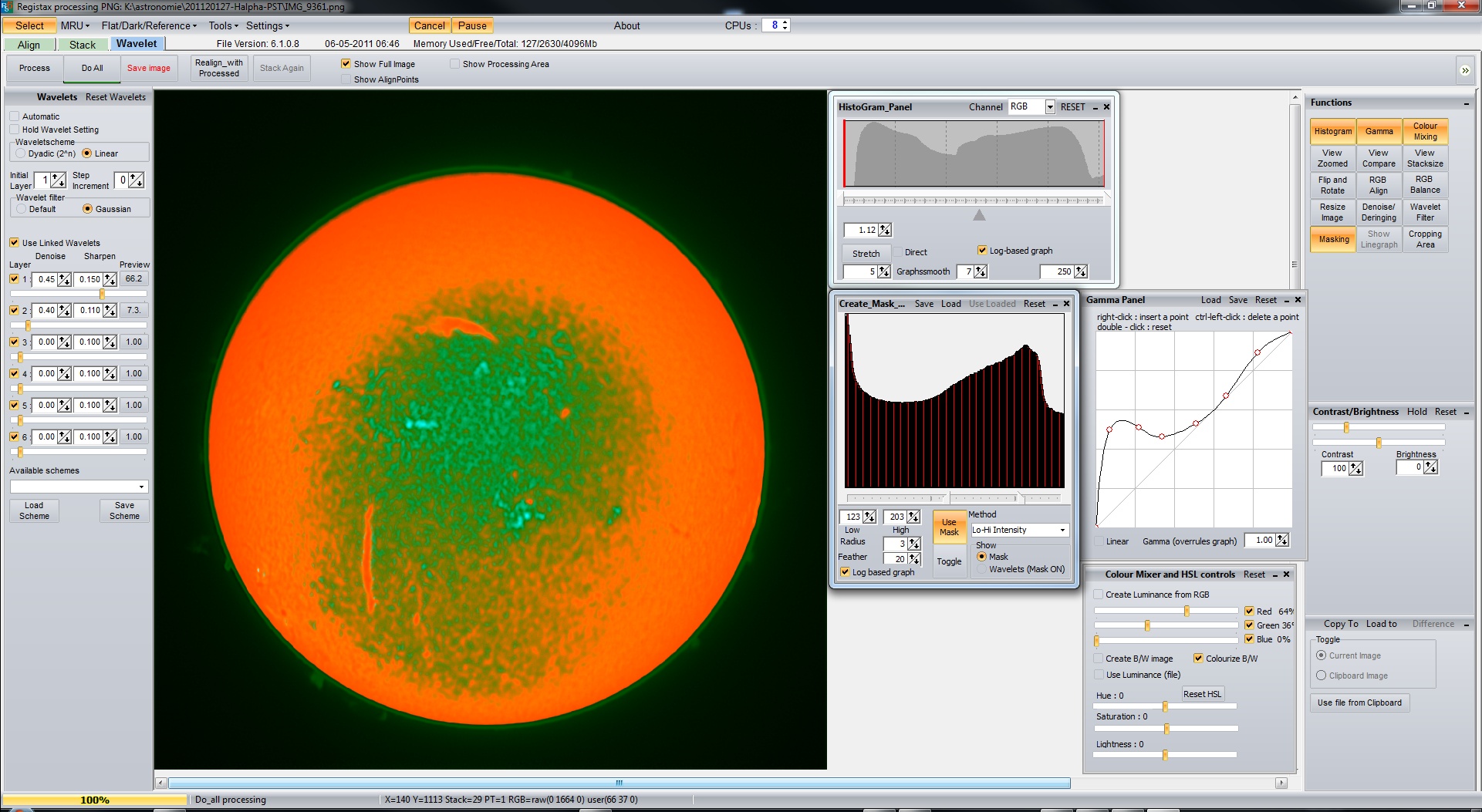
and the result :
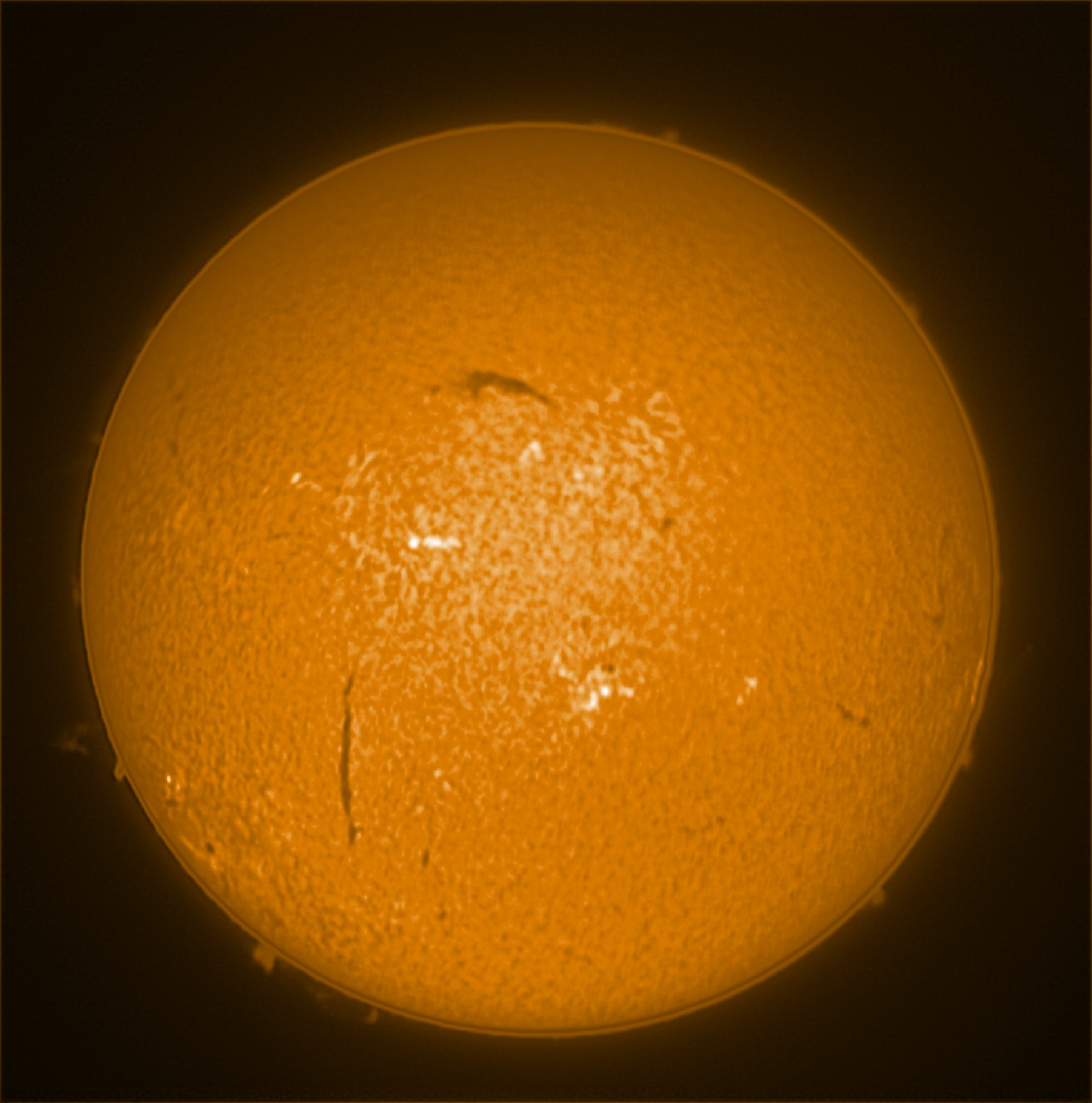
20100919+ New setups !
Has been tested following a brand new idea I had to combine two Coronado items :
PST body (including Fabry-Perot) behind a shortened 120mm F=1000mm
achromatic Skywatcher refractor + SM90 in front (= ERF & double stack) ...
GREAT SIGHT !

With
this double filtration setup I have been able do to for the first time a giant
mosaic of the Sun (20100922/12h UT) in Ha ...
Yes, because with single filtration, the structures are to difficult to match
... the eye is all but lost in the low contrast images at this magnification
...
BTW, this image shows a Sun which does not really
exits because it is the result of many fields taken from top to bottom successivelly
in about 54min,
and during that time the Sun has slightly changed !
You can download a much compressed full size image in JPG (1Mo) by clicking
on the thumbnail image below...
or here a high quality image in
JPG (6Mo) and here for the best
quality PNG version (9Mo)
Technical details :
A very powerful PC was used and
really needed ! (I7 950 at 4Ghz, 6 Gb RAM, 2To/raid0) at all time !
Camera : DMK Imaging Source 21AF04.AS 1/4" @ 60fps plus
1.6 magni-max barlow
86 x 640*480 fields taken from left to right then from right to left , etc.
... each 30s capture
Registration in Registax5 using gradient+blur filter, selection of the 500 best
images (on about 1700), gaussian wavelets (1)1/100-2/40
cropped in FINAL menu to eliminate whitish borders and saved as PNG
The mosaic has been done in PSP using a mild eraser to erase the joins and some
local selections to adjust luminosity ...
Of course there are many visible defects especially from a small distance (luminosity
and contrast variations,
changes in seeing and you cannot wait for a better one as the changes would
be important especially on the active regions ...)
but even if I have not done it yet, printing this Sun on a 1m² paper must
be impressing !
To do much better I guess a double filtration with 2 Coronado SM90+TM90 and
a full frame CCD camera should be used, but at a much higher price !
Other single double filtration images of the spectacular features from the same session :
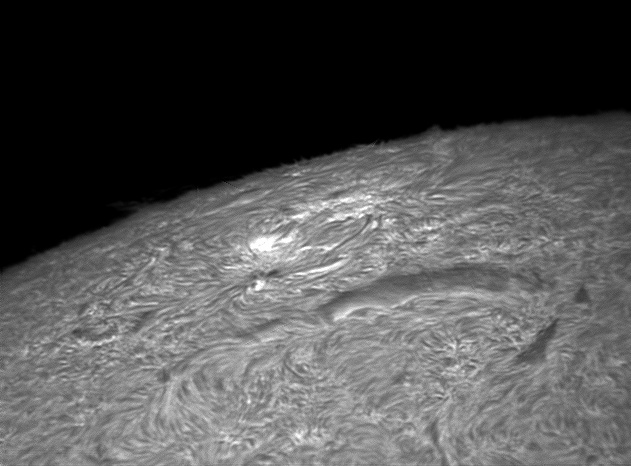
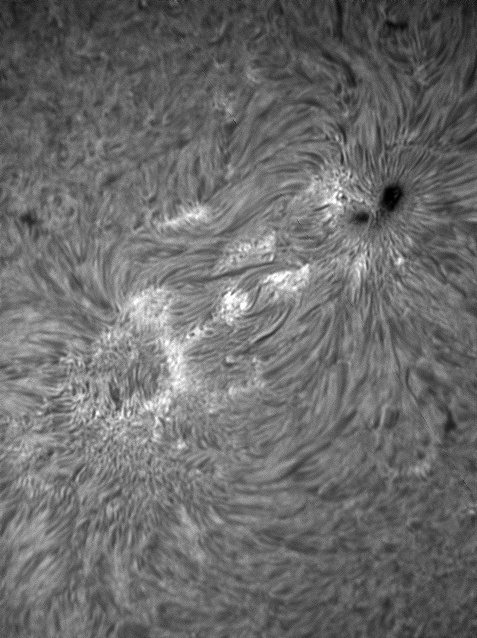 |
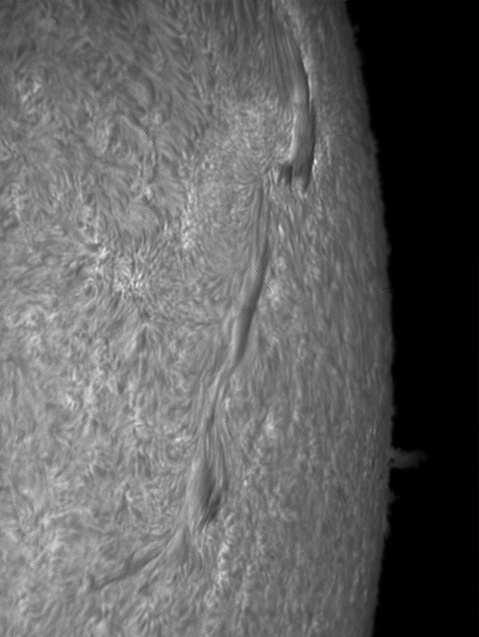 |
Previous preliminary test images of the same setup (20100920) :
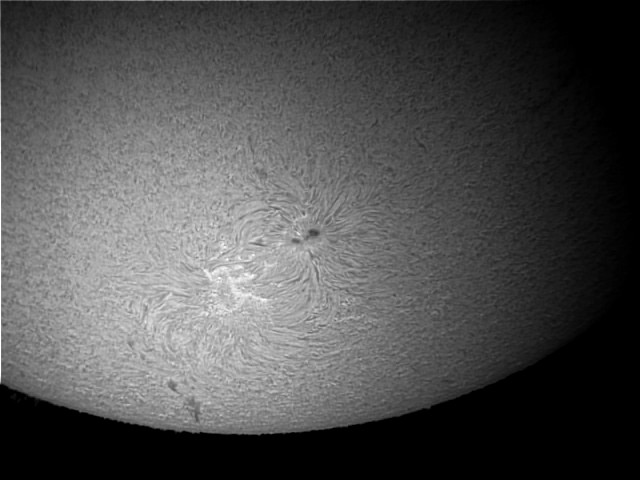 |
| FOV at primary focus with 1/3" Atik 2HS Registax 5 on 1 min 10fps AVI. A part of the image is not usable. |
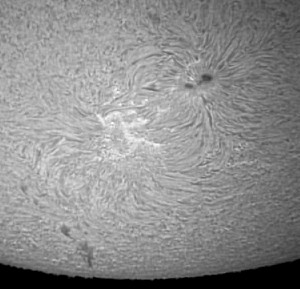 |
| Idem showing usable zone about the size of a large sunspot |
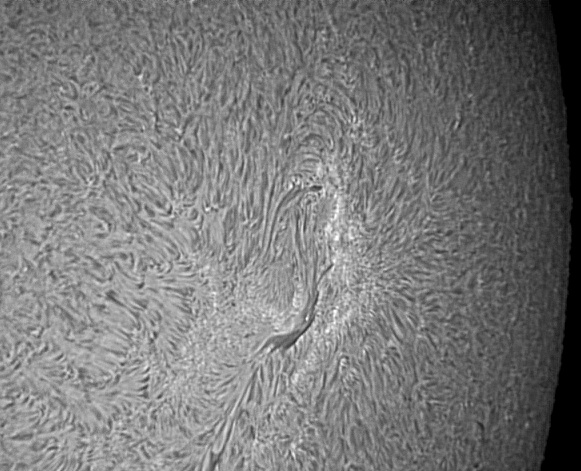 |
Now with a 1.6 magni-max barlow. Advantage 1 : it is no more necessary (compared with no double-stack) to use rather high wavelet values to obtain high contrast features ! The result is a very low noise image ! |
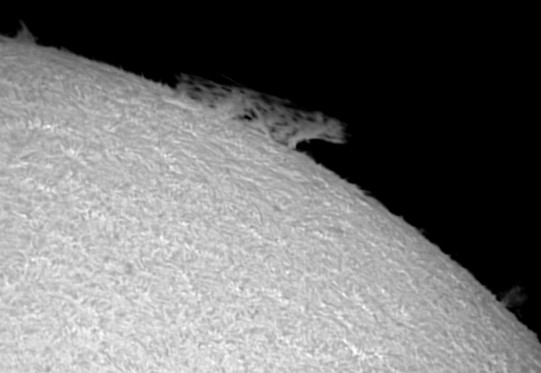 |
Also with a 1.6 magni-max barlow. Advantage 2 : It
seems to me that it is much more easy to have a correct exposure at
the same time of the prominences and disk (compared with no double-stack)
! |
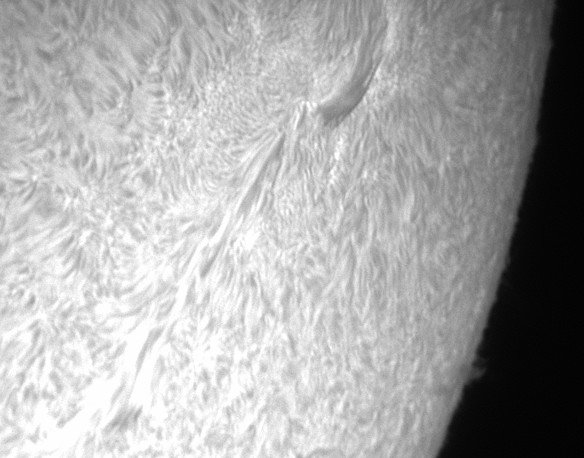 |
| Also with a 1.6 magni-max barlow. Filaments and chromosphere... |
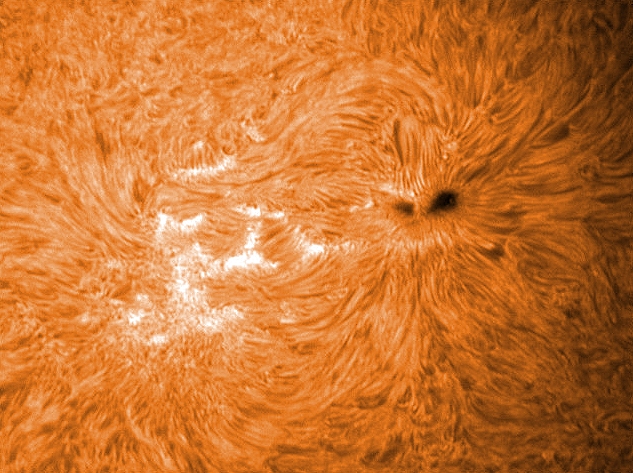 |
Sunspot #1108 and leftovers of C-class flare |
Also tested some other combinaisons allready known :
1. PST body behind a shortened 120mm refractor
+ Hershel Prism (ND filter removed) ...
Amount of light is Ok for webcams or CCD cameras, a bit dark for my eyes
Focus is hard to achieve ... needs more shortening (about 180mm of the tube
should be cut). Maybe one day as above solution is much better !
2. Also tested below PST double stack with a SM40 and tuner ... not 2x better
but 10 times !
Not only can I see the structures on the disk better (contrast, 3D feeling)
but I see much more structures !
I used this hybrid mount :
The yellow tube with internal diameters of 85/75/70mm was done a year ago by
Olivier Marechal so I would be able to fix the
SM40 on different refractors,
the aluminium one of internal 50mm diameter with pushing and pulling screws
(and 2 small screws for the lever) done by Jean-Jacques
Poupeau in order to be able to precisely tune the SM40.
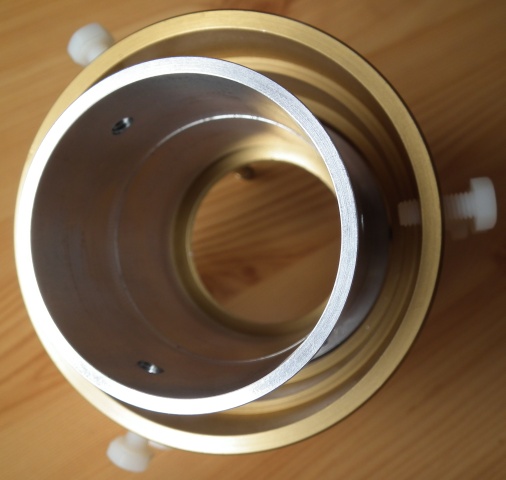
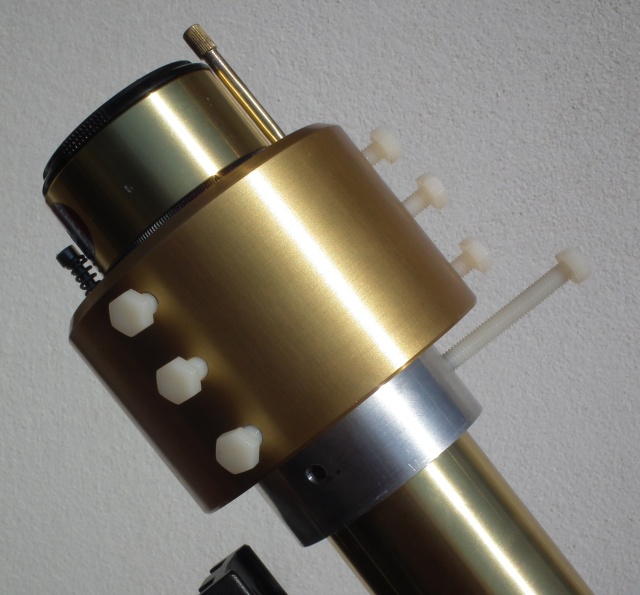
Left normal
PST and right doublestack PST (with SM40). All images taken under steady
skies within one quarter an hour. DMK
21AF04.AS @ 30fps during 1 min. Registax processing. |
|
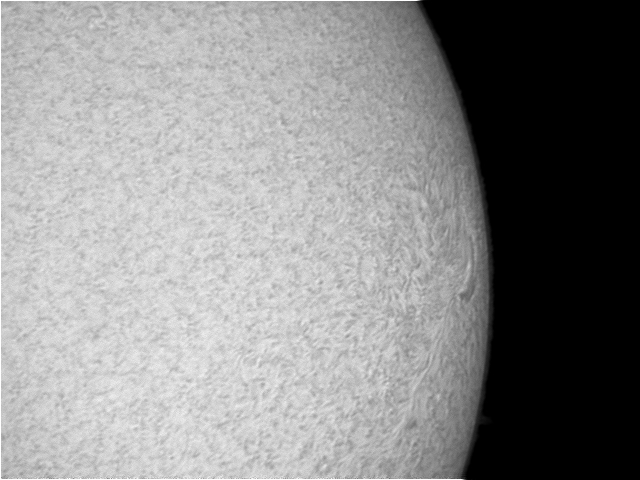 |
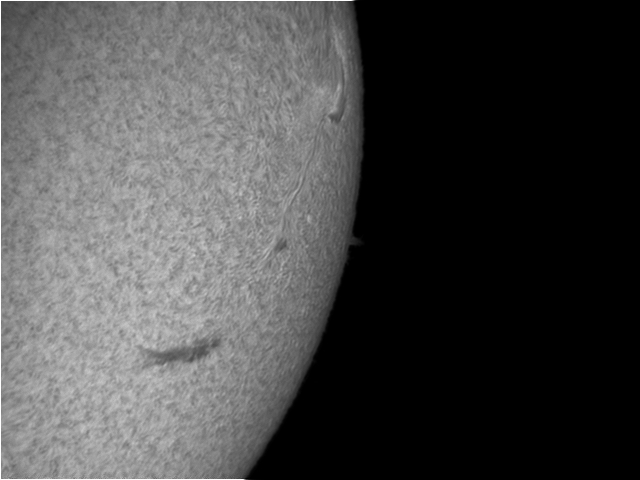 |
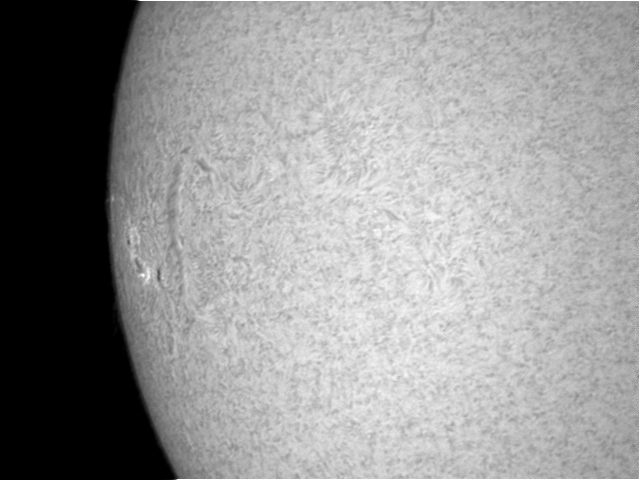 |
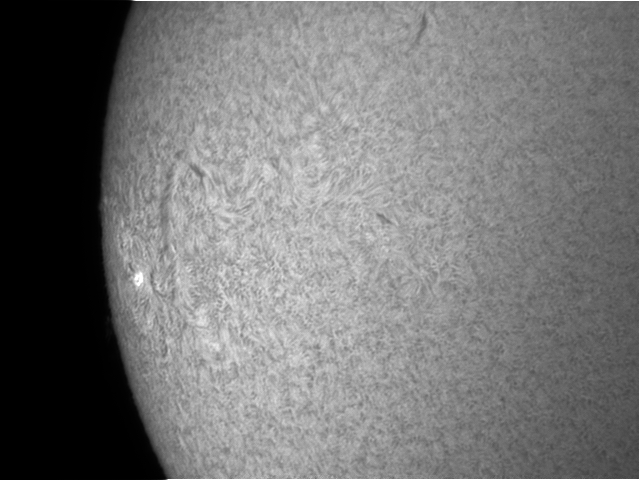 |
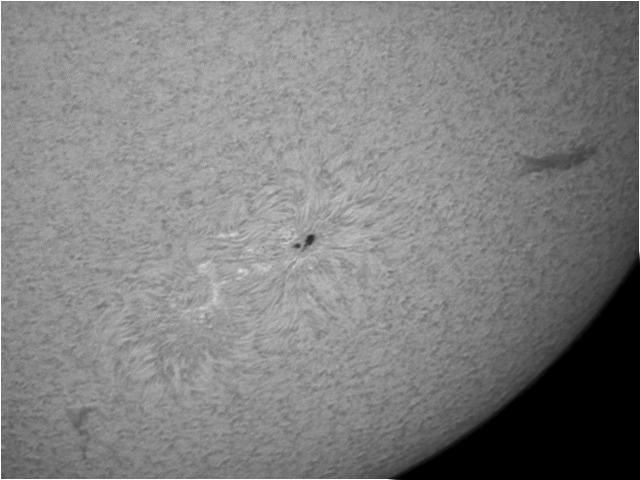 |
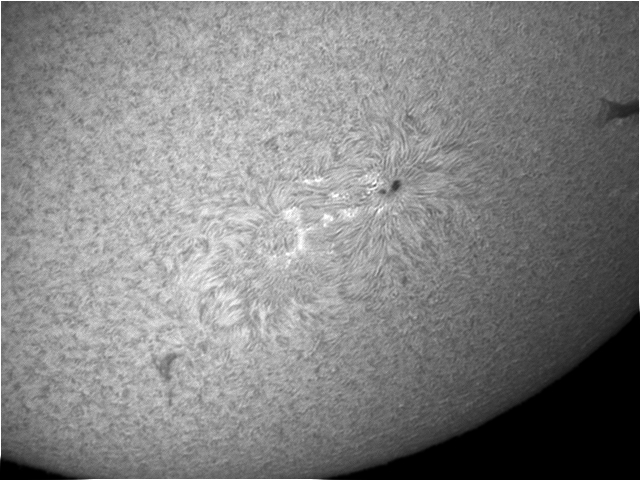 |
In that session I had a very lucky transit !
click for 29fps
divx movie and here for 2fps
one...
(Identification ? Yes, thanks ! mail to me : sweiller at free dot fr)
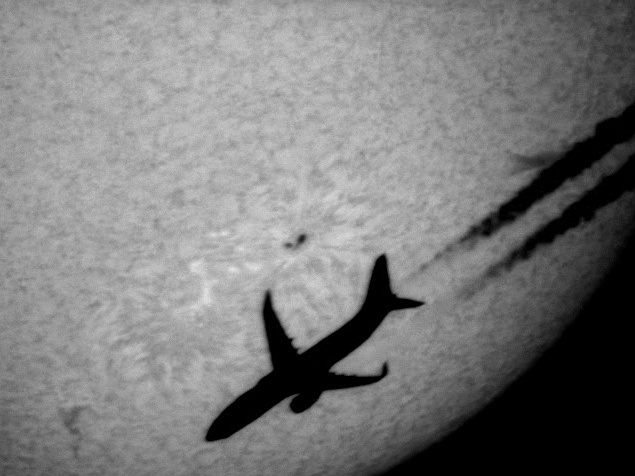
--------------------------------------------------------------------------------------------------------------------------------------------------------
20091119 session ...
Note : I bought a very good second hand,
moded PST, on 2005/05/11 !
My first one has been refurbished by Meade Europe (specials
thanks to them !)
PST (refurbished) on LX200 SCT for guiding,
Meade 2X barlow specially mounted for the PST (see here),
Canon 40D in liveview mode, RAW+LJPG, ISO 400, 1/100 exposure x 30, Registax5,
high gamma to see prominences on the left, 1:1 scale cropped from PNG !
Registax5 codes :
IMG_0125Repro_20091119_150142_ST26_WSL1_`0G_WVX_1000_500_10_10_10_CB100_0_GA100_20091119_171210_ST0_WSL1_`0G_WV10_10_10_10_10_10_CB100_0_GA190-Histo5-255-crop.jpg
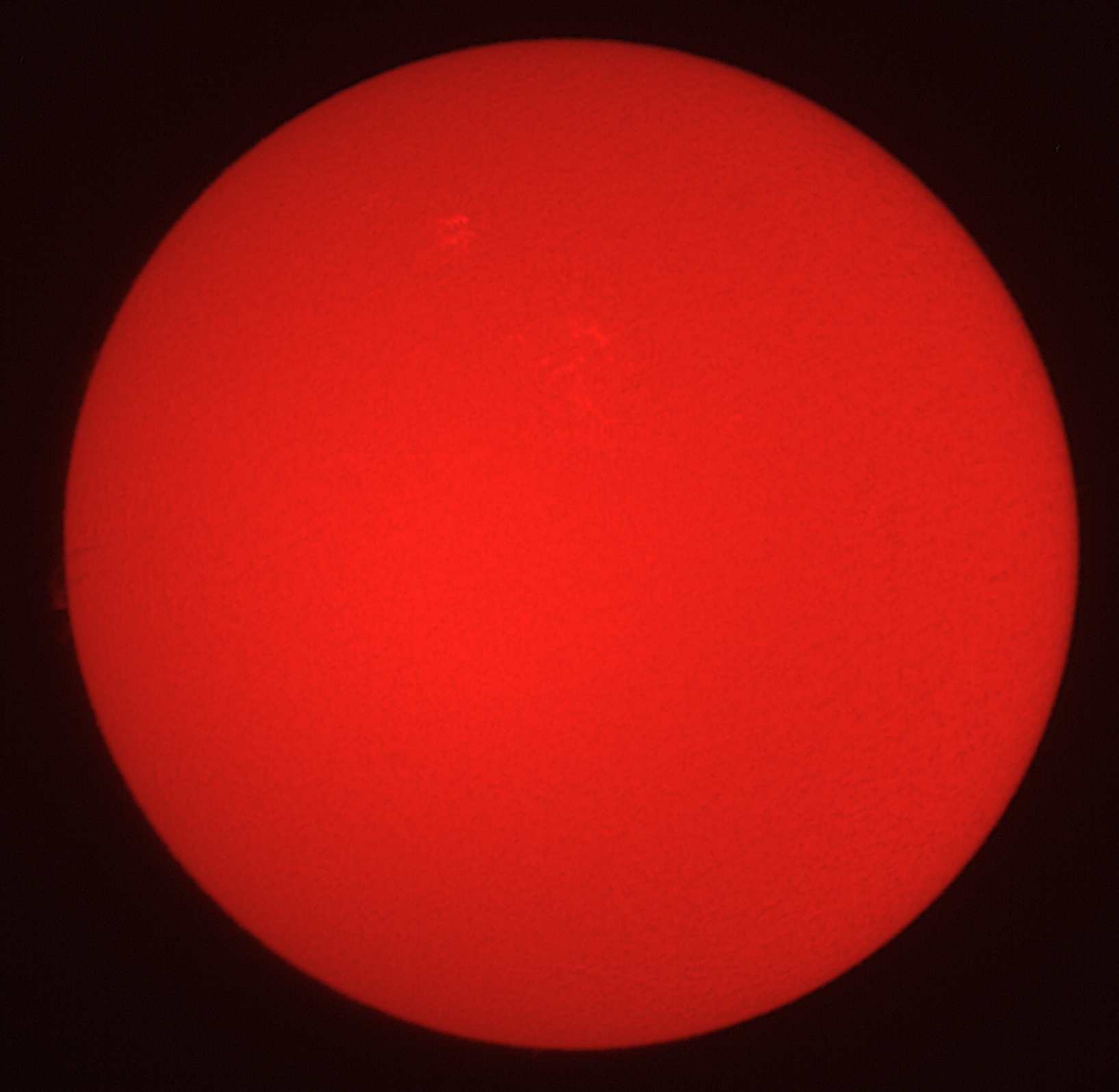
Below single best image in JPG ...
or if you want to see really how it shows, click
here for
original 40D-RAW-CR2 (10Mo !)
Note : free softwares that will open this very large 3888*2592
image in full size are rare ... then Registax5 is recommended !
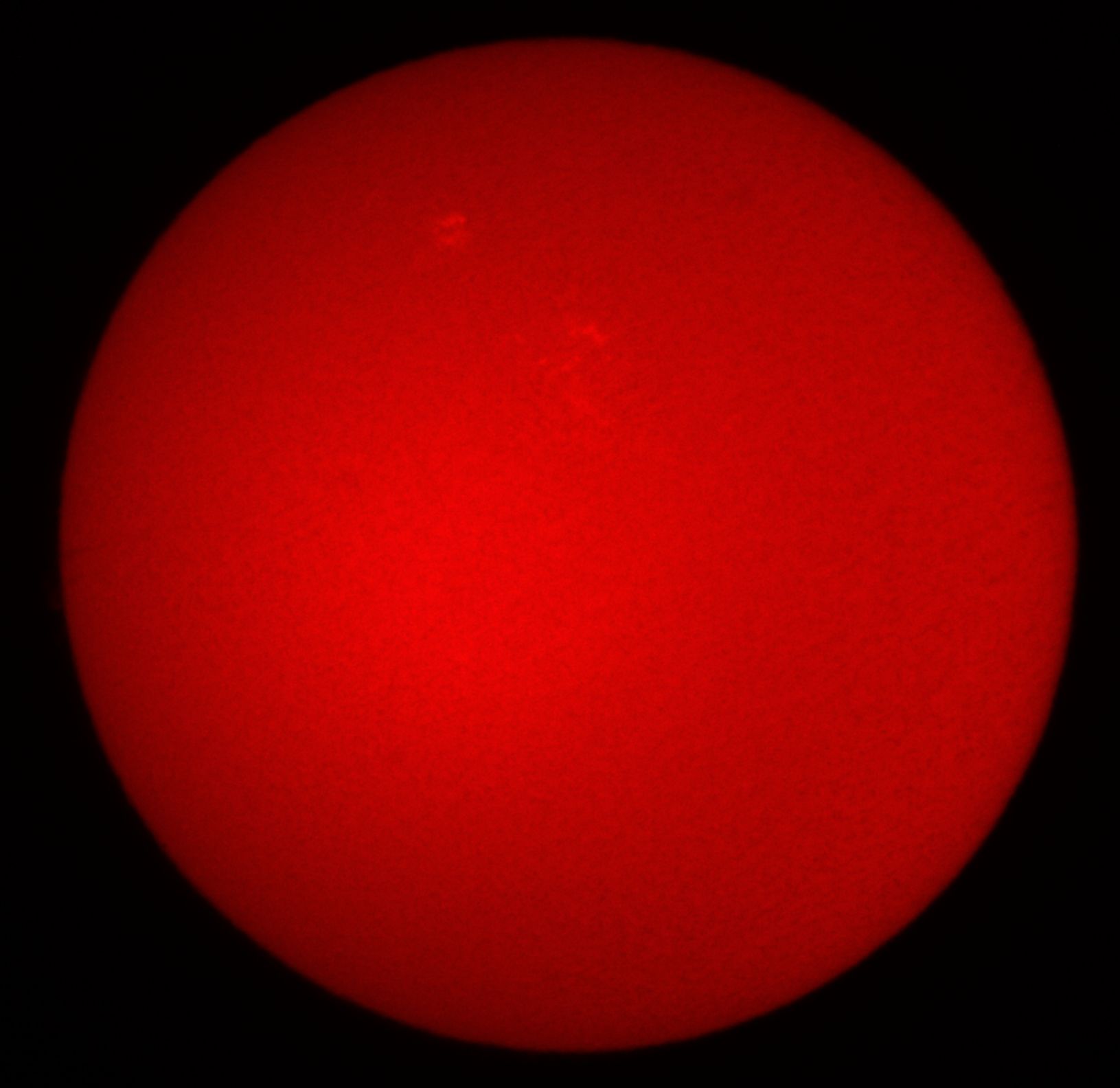 BW
image in Registax5...
BW
image in Registax5...
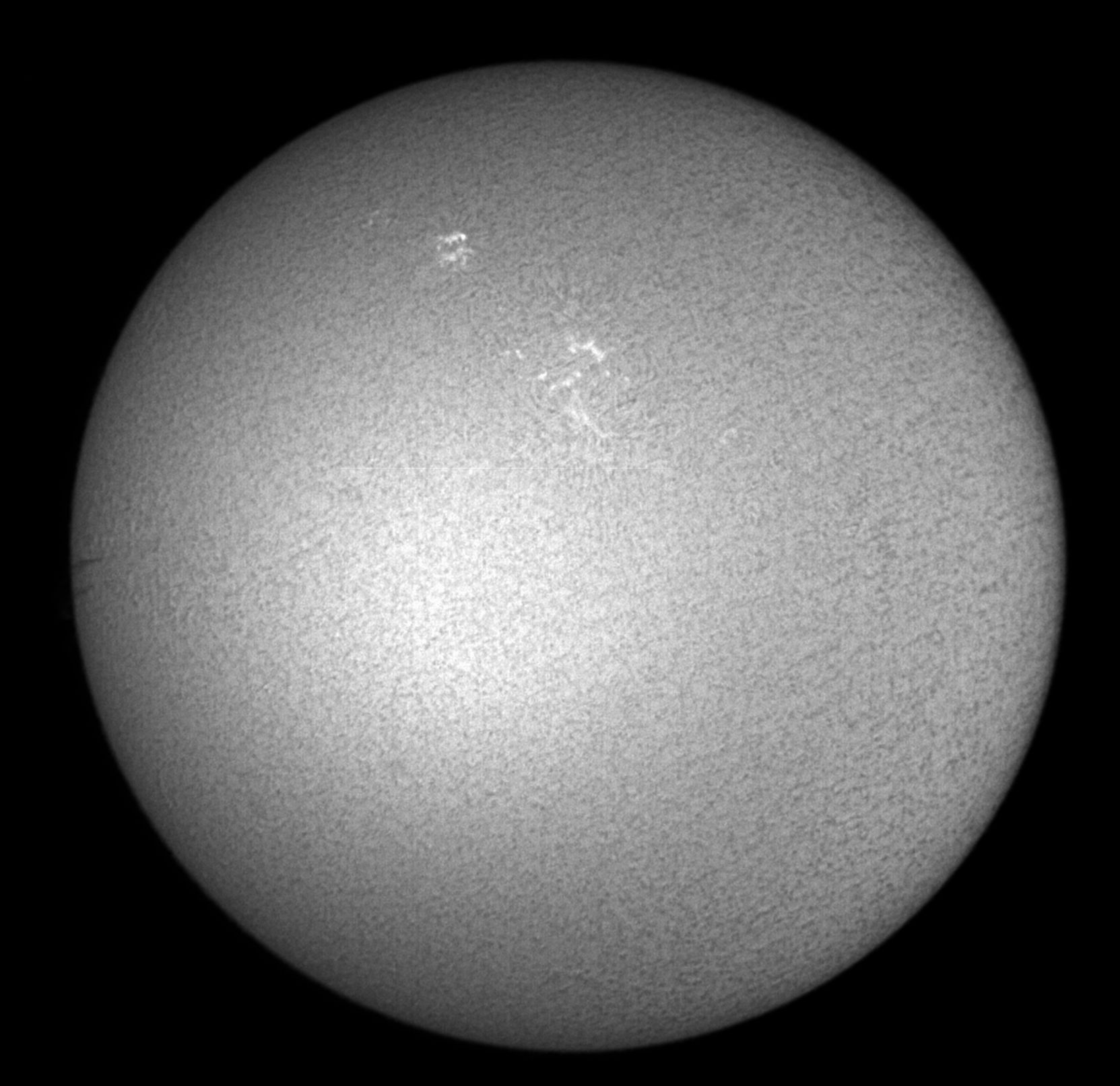
20050511 session ...
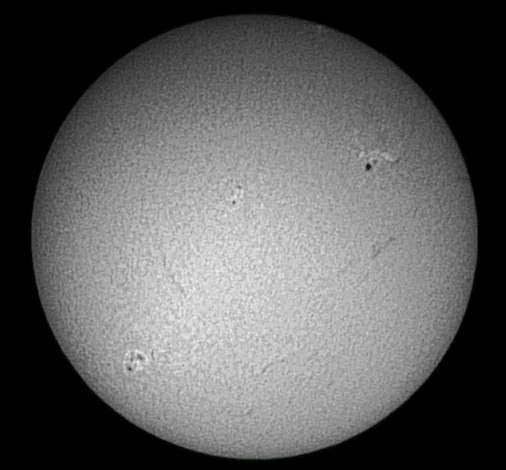 |
Original PST image 20050511-1551UT ToucamPro B&W raw mode AStrosnapPro, 100 frame integration |
 |
Processing in PSP
Dupicate image |
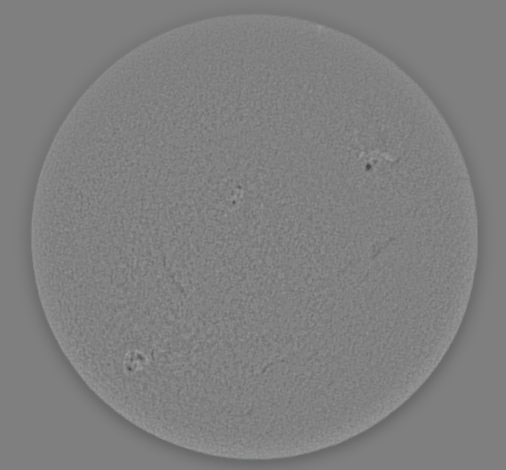 |
Add both images divisor 2 |
 |
Adjust Lumin/Contrast for this kind of look ! |
 |
Colorize 23/255 |
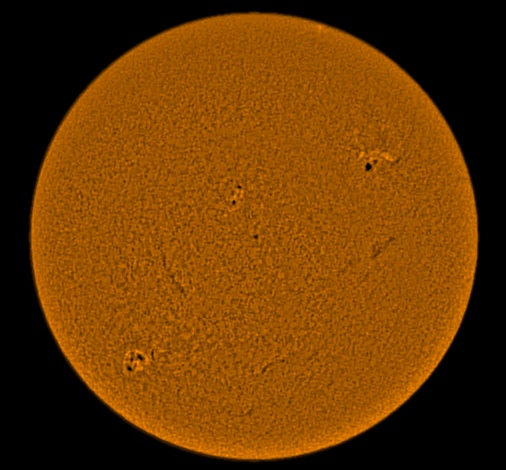 |
Make a circle selection , invert selection and
suppress to black You have now a sun with flat aspect ! |